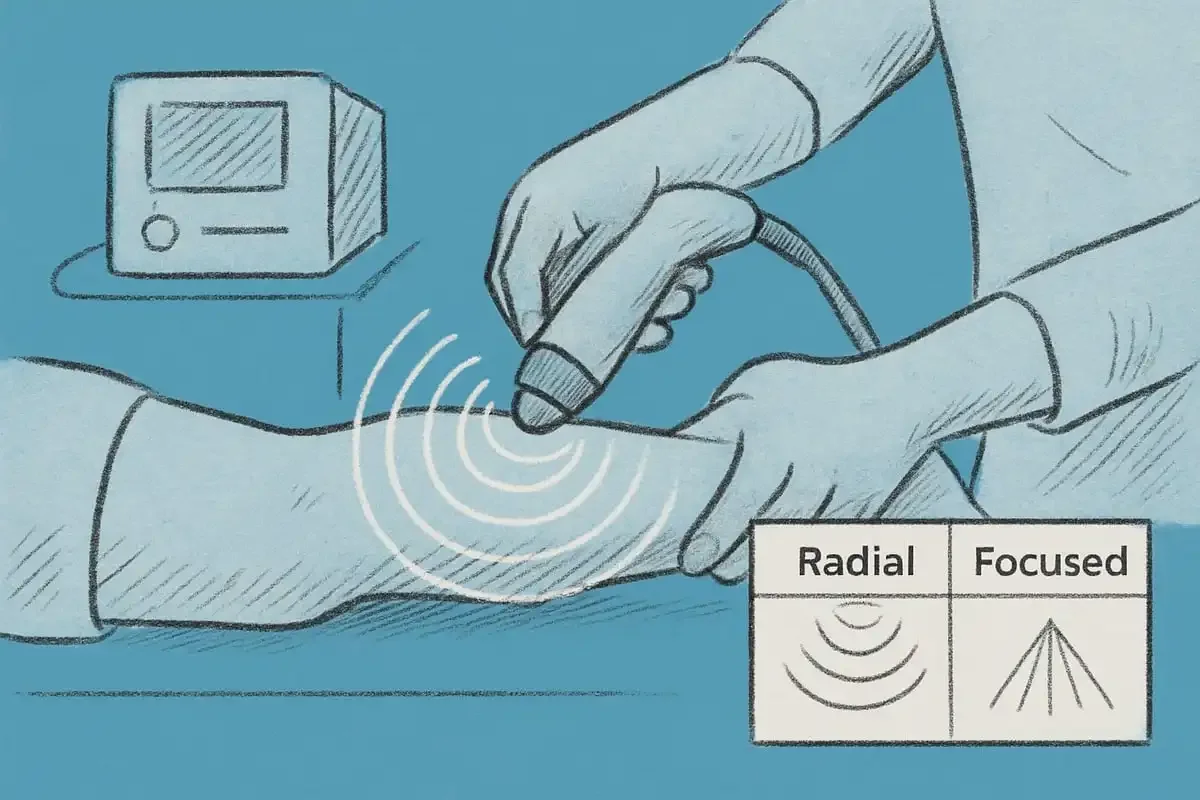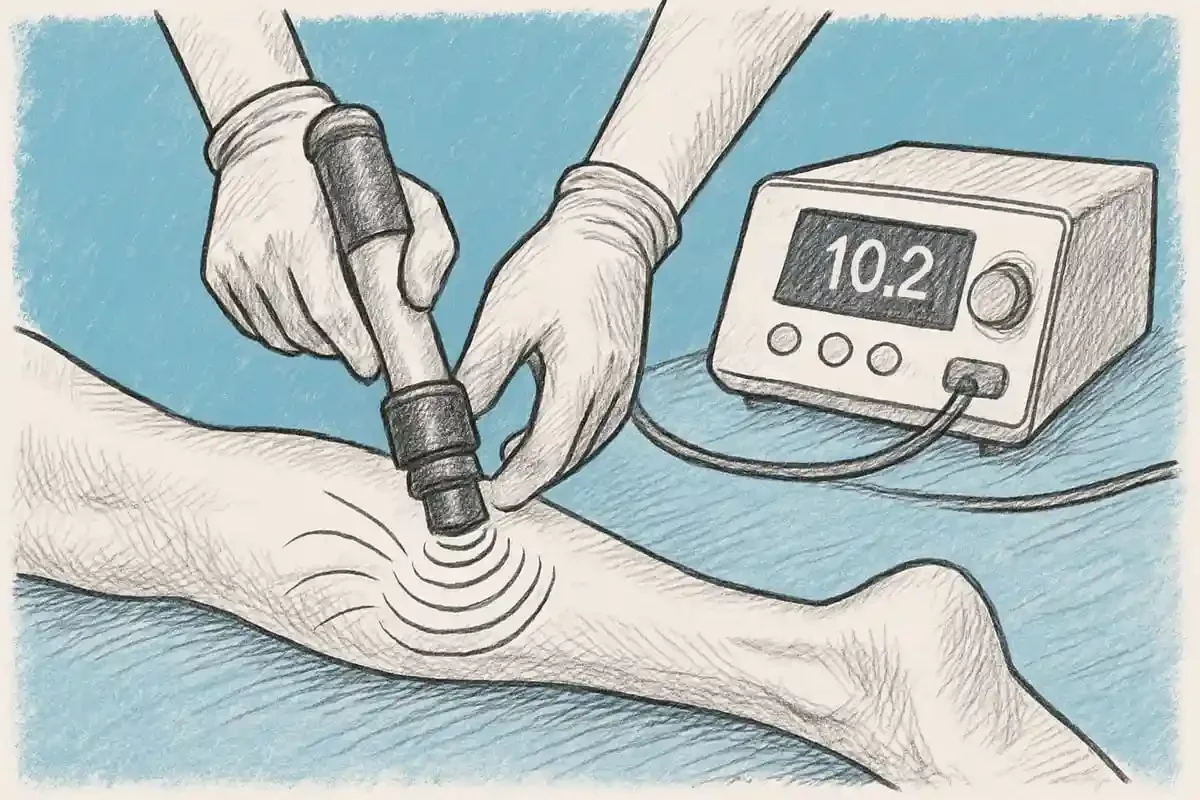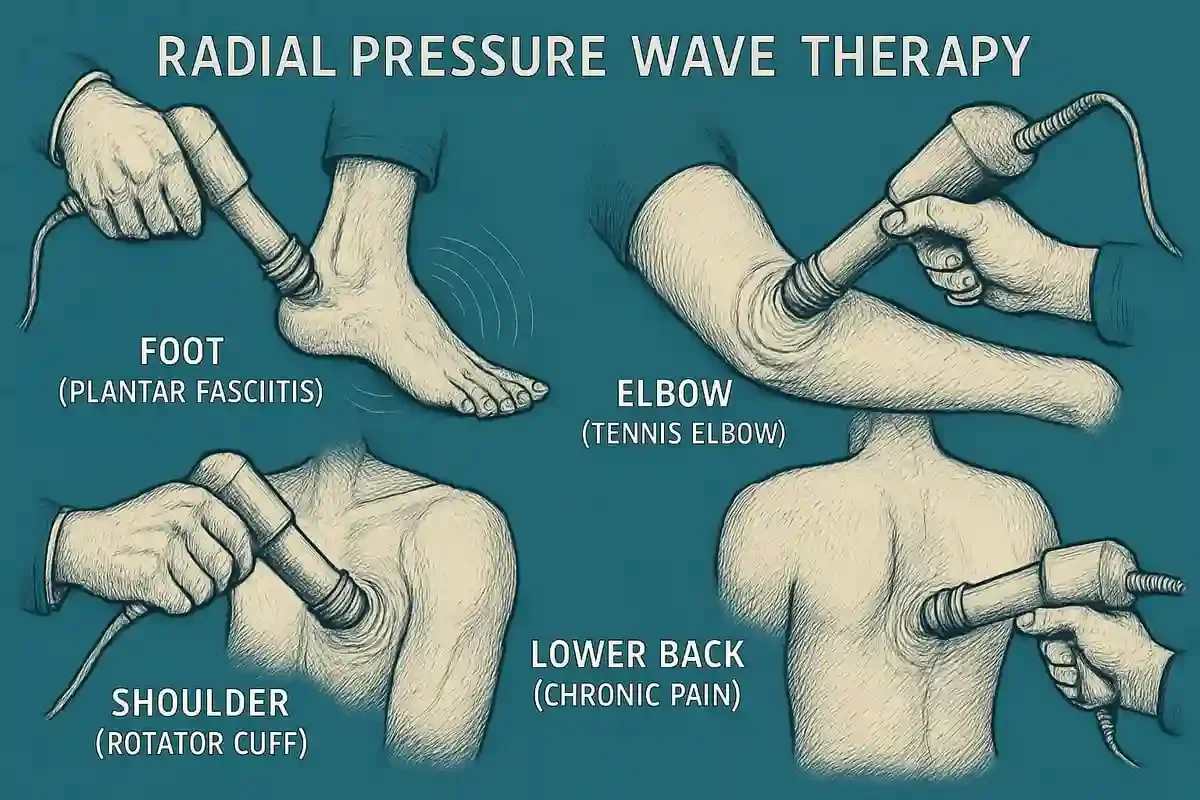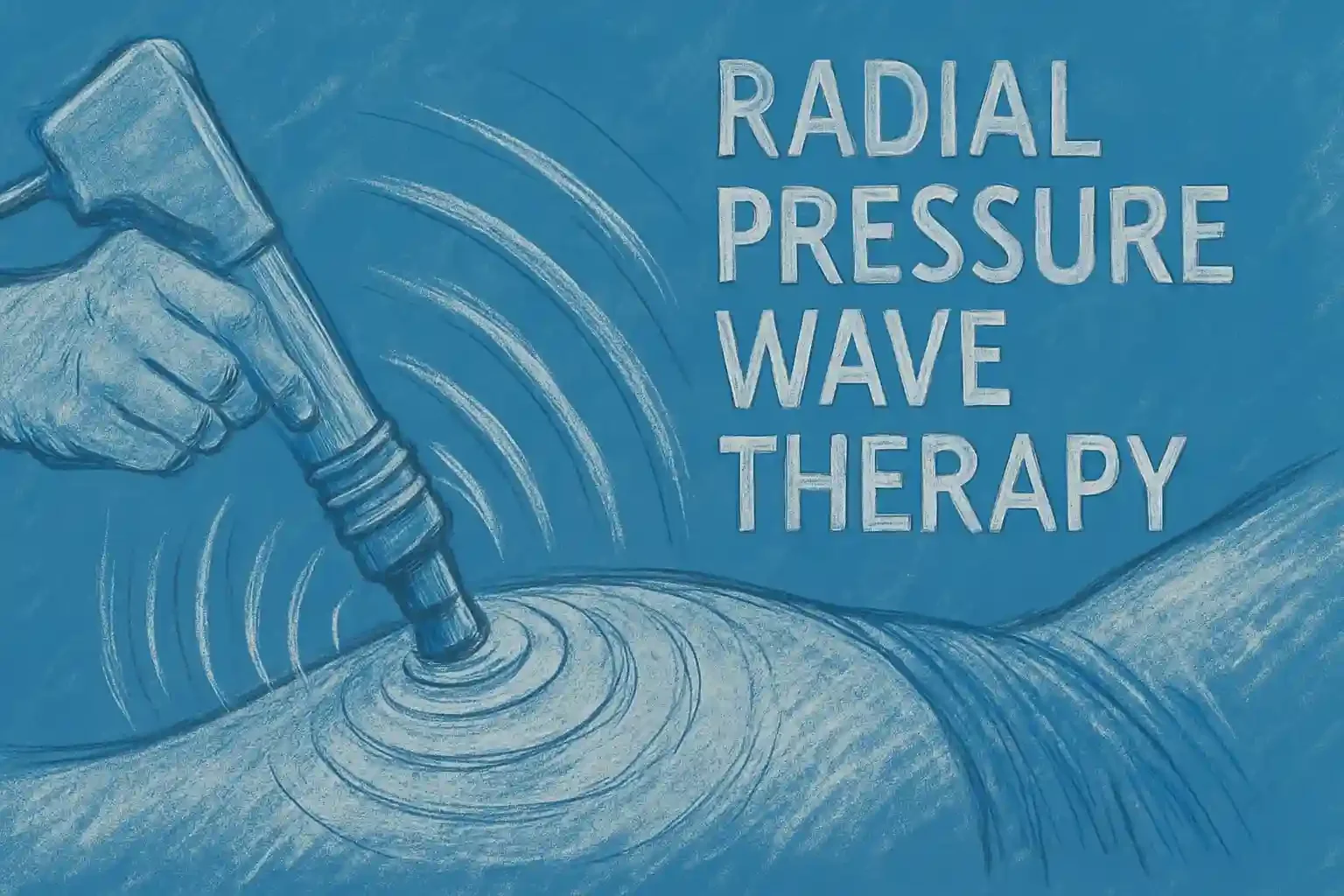Radial Pressure Wave Therapy: Insights for 2025
Non-invasive pain management is rapidly transforming how people recover from injuries and chronic conditions. As clinics and patients seek innovative solutions, radial pressure wave therapy is emerging as a leading option for effective musculoskeletal and chronic pain relief.
This guide explores why radial pressure wave therapy stands out in 2025, covering how it works, its proven benefits, clinical uses, the latest research, and what lies ahead. You will discover a technology overview, step-by-step treatment process, clinical applications, advantages, recent breakthroughs, and future trends.
Ready to make informed decisions about pain relief in 2025? Let’s dive in.
What is Radial Pressure Wave Therapy?
Radial pressure wave therapy is transforming the landscape of pain management and rehabilitation. Unlike traditional treatments, this non-invasive approach harnesses acoustic energy to target musculoskeletal and chronic pain. But what exactly sets it apart from other shockwave therapies?
Defining Radial Pressure Wave Therapy
Radial pressure wave therapy uses mechanical pulses, or pressure waves, generated by a specialized device. These waves travel outward from the applicator, dispersing energy over a broader area of tissue. In contrast, focused shockwave therapy delivers energy deeper and in a more concentrated zone.
The science behind radial pressure wave therapy involves rapid changes in pressure that stimulate biological responses. These include increased blood flow, new vessel formation, and cellular repair. The acoustic waves induce controlled microtrauma, encouraging the body’s natural healing mechanisms.
Table: Radial vs. Focused Shockwave Therapy
Feature / Radial Pressure Wave / Focused Shockwave
Energy Dispersion / Broad, superficial / Deep, pinpointed
Penetration Depth / 1-3 cm / Up to 12 cm
Common Indications / Tendon, fascia / Bone, deep tissue
Patient Sensation / Mild, tolerable / Sharper, intense
Evolution and Terminology
The concept of radial pressure wave therapy emerged in the late 1990s, evolving from focused shockwave technologies initially used for kidney stones. As research advanced, clinicians found that lower-energy, radial waves provided effective pain relief for soft tissue and musculoskeletal injuries.
Industry terminology can be confusing. “Shockwave therapy” is an umbrella term, often used interchangeably for both radial and focused modalities. RPWT refers specifically to the radial form, while ESWT (Extracorporeal Shock Wave Therapy) is often used to describe both radial and focused treatment. For a deeper dive into these differences and similarities, see ESWT Shock Wave Therapy Explained.
Safety, Devices, and Global Standards
By 2025, radial pressure wave therapy devices must meet strict international safety and quality standards. Regulatory bodies like Health Canada have approved various platforms for clinical use. Modern devices feature digital energy controls, ergonomic applicators, and user-friendly interfaces.
Leading RPWT devices include the Storz Medical MASTERPULS, Chattanooga Intelect RPW, and Zimmer enPuls. These systems offer adjustable frequencies and energies, allowing for precise customization according to patient needs.
Practitioners are should have specific training to ensure safe and effective delivery, like those at Mountain Health and Performance. Device maintenance and routine calibration are also mandated by regulatory agencies.
Adoption and Patient Outcomes
Radial pressure wave therapy is now widely adopted in physiotherapy clinics, sports medicine centers, and multidisciplinary practices. .
Patient satisfaction remains high, with surveys indicating that over 80 percent of individuals treated for conditions like plantar fasciitis or tennis elbow report significant improvement. As the technology continues to evolve, adoption rates and positive outcomes are expected to climb even further.
Radial pressure wave therapy stands at the forefront of non-invasive pain management, offering both clinicians and patients a safe, effective, and versatile solution.
How Radial Pressure Wave Therapy Works: Mechanism and Process
Radial pressure wave therapy is revolutionizing pain relief and rehabilitation. But how does this innovative technology achieve such remarkable results? Let’s break down the science, patient experience, and cutting-edge equipment shaping its effectiveness in 2025.
The Science Behind Pressure Waves
Radial pressure wave therapy uses acoustic waves to stimulate tissue healing at the cellular level. These waves are generated by a hand-held device and travel through the skin, reaching superficial and moderately deep tissues. Unlike focused shockwave therapy, which targets deeper and more precise areas, radial pressure wave therapy disperses energy over a broader zone.
The biological response begins as the mechanical energy from the waves triggers microtrauma in the targeted area. This stimulates neovascularization, or the formation of new blood vessels, and boosts collagen production. Both processes are crucial for tissue regeneration and repair.
Pain modulation is another key benefit. The waves disrupt pain signals and help reduce inflammation, improving comfort. Clinical protocols adjust the energy level and frequency to match the specific condition and patient tolerance. For example, lower frequencies are used for sensitive regions, while higher energies address chronic tendinopathies.
Research comparing radial pressure wave therapy with other modalities, such as laser or ultrasound, highlights its unique advantages in accelerating healing and reducing pain. To understand these distinctions further, you can review Shockwave Therapy in North Vancouver, which explains similarities and differences between therapies in a clinical context.
The Patient Journey: What to Expect During Treatment
If you’re considering radial pressure wave therapy, knowing what to expect can ease any concerns. Treatment starts with a thorough assessment, including medical history and a physical exam. The practitioner then tailors a plan, selecting the right device settings and session frequency for your needs.
During a typical session, you’ll feel a series of gentle-to-moderate pulses or tapping sensations as the applicator moves over the affected area. Most people describe the sensation as mildly uncomfortable but tolerable, lasting about 4 to 10 minutes per session.
Protocols often involve one session per week for three to six weeks. After each session, patients can usually resume normal activities quickly, with only minimal post-treatment care such as ice or gentle stretching.
Safety is a major advantage of radial pressure wave therapy. Side effects are rare, usually limited to temporary redness, mild swelling, or minor bruising. Contraindications include pregnancy, blood clotting disorders, and certain malignancies, so a skilled practitioner will always screen for these risks.
For example, in treating chronic Achilles tendonitis, most patients notice significant improvement in pain and function within a few weeks. Real-world results show high satisfaction and rapid recovery timelines.
Technology and Equipment in 2025
In 2025, radial pressure wave therapy devices have evolved with impressive features. Modern systems offer ergonomic applicators that reduce practitioner fatigue and improve precision.
Maintenance and calibration protocols have become more streamlined, ensuring consistent performance and safety.
Industry data shows that new-generation radial pressure wave therapy devices are being adopted worldwide at a rapid pace, especially in multidisciplinary rehabilitation centers. These advancements make the therapy more accessible, efficient, and effective than ever before.
Clinical Applications: Conditions Treated with RPWT
Radial pressure wave therapy is rapidly transforming pain management and rehabilitation. Its versatility allows clinicians to address a wide variety of conditions, from sports injuries to chronic pain syndromes. Let’s explore the most common and emerging clinical uses for this innovative technology.
Musculoskeletal and Sports Injuries
Radial pressure wave therapy is now a frontline option for many musculoskeletal and sports-related injuries. It is frequently used to treat plantar fasciitis, Achilles tendinopathy, tennis and golfer’s elbow, and rotator cuff injuries. The therapy’s non-invasive nature makes it ideal for both acute and chronic cases.
Clinical studies have shown that radial pressure wave therapy promotes faster recovery and pain reduction compared to wait-and-see and other therapy approaches. For example, patients with plantar fasciitis often see significant improvement after a few sessions. You can read more about real-world outcomes in Shockwave and Laser for Plantar Fasciitis.
Radial pressure wave therapy offers a compelling alternative, especially for patients seeking to avoid injections or surgery.
Chronic Pain and Soft Tissue Disorders
Chronic pain syndromes and soft tissue disorders are major drivers for seeking radial pressure wave therapy. This method is highly effective for myofascial pain and trigger points. Its ability to modulate pain and stimulate tissue repair makes it an excellent choice for long-standing complaints.
Integration into multidisciplinary pain management programs is becoming more common. By combining radial pressure wave therapy with exercise, manual therapy, and education, clinics are achieving better long-term outcomes for complex pain cases.
Real-world case studies highlight how this therapy can help break the cycle of chronic pain. Most patients experience mild discomfort during sessions but report significant relief within weeks.
Emerging and Off-Label Uses
The versatility of radial pressure wave therapy is evident in its expanding list of of uses. Research supports its use for calcific shoulder tendinitis, where it can help break down calcium deposits and restore movement.
Neurological conditions, such as spasticity following stroke or brain injury, are also under investigation, albeit more in focused shockwave applications. Preliminary studies suggest that radial pressure wave therapy may help reduce muscle tone and improve mobility in select patients.
Benefits and Limitations of Radial Pressure Wave Therapy
Radial pressure wave therapy is gaining momentum as a top choice for people seeking non-invasive pain relief. This section explores both the upsides and the limitations that come with this technology, helping you make an informed decision about your care.
Key Advantages for Patients and Providers
Radial pressure wave therapy offers a host of advantages for both patients and healthcare providers. One of the biggest benefits is that it is completely non-invasive. There are no incisions or injections, making it a gentle option compared to surgery.
Patients often experience rapid pain relief, sometimes even after the first session. This quick response makes it especially appealing for those who want to return to daily activities with minimal downtime. The treatment is drug-free, which eliminates the risks associated with long-term medication use.
For providers, radial pressure wave therapy is cost-effective. It reduces the need for expensive surgical procedures and lengthy rehabilitation. Clinics report high patient satisfaction rates, with improvement rates for conditions like plantar fasciitis and tennis elbow often exceeding 75 percent.
Additional advantages include:
Minimal risk of complications or infections
Short treatment sessions, typically lasting 5 to 10 minutes
Versatility for treating a wide range of musculoskeletal issues
With these benefits, both patients and clinics are seeing better outcomes and improved quality of life.
Potential Drawbacks and Contraindications
While radial pressure wave therapy is safe for most people, it is not suitable for everyone. There are certain contraindications to keep in mind, such as blood clotting disorders, pregnancy, and the presence of malignancy near the treatment area. Accurate diagnosis is essential to avoid complications.
Some patients may experience mild side effects. These can include temporary discomfort during the session, as well as slight bruising, redness, or swelling afterward. Such effects are usually short-lived and resolve without intervention.
Limitations also exist in treating deeper or bony lesions. Radial pressure wave therapy is most effective for soft tissue conditions closer to the surface. Response to treatment can vary, and some individuals may require more sessions or alternative therapies.
Safety is a top priority. Always ensure your provider is experienced and uses certified devices for optimal safety and results.
Latest Research, Innovations, and Industry Trends for 2025
The world of radial pressure wave therapy is undergoing rapid transformation in 2025. New discoveries, smarter devices, and a growing market are setting the stage for broader adoption and improved patient care. Whether you're a clinician, patient, or industry watcher, keeping up with these trends is key to informed decisions.
Breakthrough Studies and Clinical Evidence
Recent years have seen a surge in high-quality research on radial pressure wave therapy. Meta-analyses published between 2023 and 2025 demonstrate consistent effectiveness in treating musculoskeletal pain, such as plantar fasciitis and chronic tendinopathies.
One key finding is the improved understanding of how radial pressure wave therapy stimulates neovascularization and collagen production, supporting faster tissue healing. Clinical trials now stratify patients based on age, injury type, and chronicity, leading to more personalized protocols and better outcomes.
A 2024 systematic review reported success rates above 75% for chronic soft tissue conditions, with recurrence rates dropping when combined with rehabilitation exercises. Comparative data also show that, for certain indications, radial pressure wave therapy matches or surpasses traditional physiotherapy and even some surgical interventions.
Patient satisfaction remains high, with surveys indicating rapid pain reduction and functional improvement after just a few sessions. The body of evidence now supports broader use, with new studies underway exploring applications in post-surgical rehabilitation and neurological conditions.
Technological Advancements and Digital Integration
Technology is redefining how radial pressure wave therapy is delivered and monitored. The latest devices in 2025 boast ergonomic applicators, and precise energy control.
Market Growth and Future Outlook
The global market for radial pressure wave therapy is expanding quickly. By 2025, the demand is fueled by an aging population, increased preference for non-invasive treatments, and growing clinical evidence supporting efficacy.
Industry analysts project a robust compound annual growth rate, with the shockwave therapy devices segment expected to reach significant milestones in the next decade. Regulatory changes and improved reimbursement policies are making these treatments more accessible in both urban and rural areas.
According to a recent Shockwave Therapy Devices Market Growth Forecast, the sector is set to surge, reflecting both technological innovation and patient demand. Experts predict future research will unlock even more applications, cementing radial pressure wave therapy as a mainstay in modern rehabilitation.
Choosing a Radial Pressure Wave Therapy Provider: What Patients Should Know
Selecting the right provider for radial pressure wave therapy is essential for achieving the best results and ensuring a safe, effective experience. With more clinics offering this innovative approach, knowing what to look for can help you make a confident, informed decision.
Credentials and Experience to Look For
Experience and certification matter greatly when choosing a radial pressure wave therapy provider. Seek clinics where practitioners hold up-to-date credentials from recognized physiotherapy or medical boards. Training in the use of RPWT devices and adherence to safety standards are non-negotiable.
Ask providers about their experience with your specific condition. For example, if you need RPWT for calcific tendinitis, inquire about their familiarity with treating that condition. 2
A reputable clinic should have device certifications and follow the latest safety guidelines. Multidisciplinary clinics, where chiropractors, massage therapists, and rehabilitation specialists collaborate, often achieve better patient outcomes.
Checklist for Choosing a Provider:
Certified, experienced practitioners in radial pressure wave therapy
Accredited clinic with up-to-date safety protocols
Device certifications and regular equipment maintenance
Clear communication about expected outcomes and risks
Experience with your specific diagnosis
Selecting a provider with these qualifications maximizes the potential benefits and minimizes risks associated with radial pressure wave therapy.
What to Expect: Costs, Insurance, and Accessibility
Understanding the costs and insurance coverage for radial pressure wave therapy is crucial before starting treatment. In 2025, the average session typically ranges from $100 to $150, depending on the clinic, location, and complexity of your condition.
Urban centers tend to have greater clinic availability, while rural areas may face access challenges. However, the global market for shockwave therapy devices is expanding rapidly, increasing accessibility. For more details on market growth and device availability, see the Shock Wave Therapy Devices Market Report 2024-2032.
Sample Cost Breakdown Table: / Service / Typical Cost (USD) / Insurance Coverage
Initial Assessment / $100 – $180 / Partial/Full
Per RPWT Session / $100 – $250 / Partial/Full
Multi-Session Package / $800 – $1,200 / Varies
Patient Testimonials and Real-World Results
Our North Vancouver patients consistently report high satisfaction rates with radial pressure wave therapy. Most people experience noticeable pain reduction and improved mobility within a few sessions, especially for chronic tendon or soft tissue conditions.
Setting realistic expectations is key. While many benefit from radial pressure wave therapy, results can vary based on diagnosis, provider expertise, and adherence to recommended protocols.
If you’re ready to explore the latest in non invasive pain relief after learning about Radial Pressure Wave Therapy and its impressive benefits for musculoskeletal conditions you’re not alone. We’ve seen how RPWT is changing the game for chronic pain and injury recovery and you deserve to experience these advancements firsthand. At Mountain Health and Performance our experienced team uses state of the art technology and personalized care to help you get back to doing what you love. Curious to see if RPWT is right for you in North Vancouver? Take the next step and book your shockwave session today.




